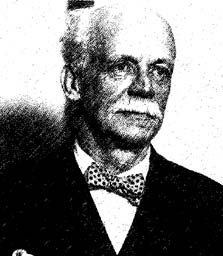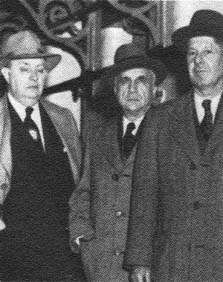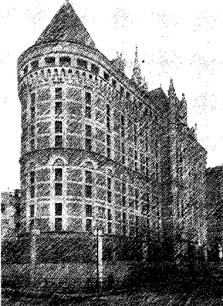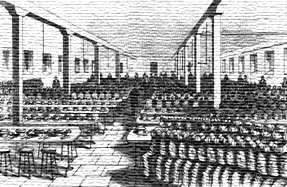VI:
The Crime Wave of
the 1920s and 1930s
Soon after World War I, national concern began to focus on the "crime wave" of gangsters and general lawlessness then sweeping the nation. . . . Moreover, juvenile delinquency seemed to be "developing in all places."
. . . . the Association noted that in 1920 there was actually a decrease in the number of cases coming before the Children's Court in New York City.' Similarly, in 1937 the National Crime Commission . . . reported that the proportion of young persons arrested for various offenses was less than "a generation ago.
. . . Among the measures suggested [in the public clamor] for more severe forms of punishment were "the whipping post for wife beating; the condoning and even advocacy of flogging as a part of prison regime"; and the reduction in prisoners' privileges.' One suggestion, which was enacted into law in 1926, provided for life imprisonment for persons convicted of four felonies; it would become an early but failed precursor of the highly publicized three strikes" provision in the 1994 federal crime bill. . . .
Reform Efforts
Seeking to avoid the polemics of prosecutors, politicians, and prison officials about who was responsible for the increase in organized crime activities, the Association took a major role during the post-World War I years in urging a series of reforms to the criminal justice system. . . .
Lunacy Commissions. One reform supported by the Association was the use of "scientific methods and machinery" to understand what kind of person becomes a criminal, what are the chief causes for his criminal behavior, and how those causes can be "removed or neutralized." One means of accomplishing this would be through the use of psychiatrists to examine felons in order to ascertain the degree to which mental disease was an element in their criminal behavior.
Responding to this Association's prodding, New York State had already established a psychiatric clinic at Sing Sing Prison to receive and classify incoming inmates based on their psychiatric profile. The Association felt strongly that without scientific (meaning psychiatric) methods to diagnose and classify inmates based on mental diseases,
|
any system of crime treatment which attempts to measure the exact degree of culpability contained in a given crime, and to prescribe precisely the amount and quality of penalty necessary to balance the offense, is absurd, and inevitably unjust in its application, and too often defeats the most important object in connection with the treatment of the criminal, namely, the protection of society. |
For nearly two decades the Association was at the center of the battle over state lunacy commissions, which were intended to carry out these types of examinations. The Association's stance on this issue shifted back and forth during the debate. In 1927 the Association bemoaned the high cost and poor results arising from the system then in existence, under which a person who entered an insanity plea was examined by a three-person lunacy commission appointed by the court. None of those persons "need have had any training whatever in the care and treatment of the insane, and it is not even necessary ... that they should ever have seen an insane person." The Association publicized the high cost of the examinations -- from $700 to nearly $ 1,000 per person -- and suggested that "a form of patronage is being exercised by the judges."
|
While the Association was calling for careful study, other penologists were in favor of more aggressive steps to curtail crime, including censorship of movies and literature depicting gangsters. The Ninth International Prison Congress, held in London on August 3, 1925, adopted a resolution urging "every country" to set up "an effective film censorship" mechanism to deal with "all matters connected with the cinemas, calculated to injure or deprave the young."
Eighty-first Annual Report -- 1925, pp. 81-82.
|
Laws were passed in 1936 that did not "entirely remedy the situation," and the following year the Association noted that "the result has been disappointing in that too many commissions are still being appointed, and the personnel of these commissions lack suitable qualifications." The Association thereupon withdrew its support for the new legislation and reverted to its original position that "the courts use the qualified psychiatric personnel at Bellevue [and other hospitals] to determine the question of a prisoner's mental condition."
The Association's views on reforming the lunacy commissions gained credence when a policeman was murdered in 1938 by a suspect already under the care of a lunacy commission. Media attention on the inadequacies of the existing patronage system gave impetus to a repeal of the lunacy commissions and the enactment of legislation requiring the courts to appoint two qualified psychiatrists to examine insanity cases. The Association noted:
|
The campaign against lunacy commissions is another instance of pioneering on the part of the Prison Association and the patience and persistency required to bring about desirable changes. In the beginning the Association stood practically alone, but the increasing force of the various attacks doomed the continuance of the commissions." Ultimately, in 1939 the Association succeeded in convincing the Governor and the Legislature to abolish these commissions and replace them with a system of court-appointed psychiatrists.
Ninety-fifth Annual Report -- 1939, pp. 33-35.
|
Habitual Criminal Act. Another reform activity by the Association was its interest and participation in the work of the State Crime Commission, formed in 1925 to study the "administration and execution" of the state's criminal laws and to propose new laws and methods of enforcement.
Among the chief areas of inquiry by the commission were
- the inefficiencies in procedural rules affecting trials and evidence;
- the lack of cooperation among law enforcement agencies in exchanging information on crimes and identification of criminals;
- inequalities in sentences given by judges for comparable crimes;
- the lack of vocational training and other employment opportunities in state prisons;
- the need for more facilities to handle inmates with psychiatric problems;
- the need for a full-time parole board to ensure proper administration of the system of indeterminate sentences;
- abuses in the plea-bargaining process; and
- an examination of a myriad of factors affecting the swift and equitable administration of justice.
The State Crime Commission's most public and noteworthy recommendation was the Fourth Felony Offender Act, and it was quickly enacted into law. Known also as the Habitual Criminal Act, it provided for life imprisonment upon conviction for a fourth felony. Similar in tenor to the proposal by President Clinton for the centerpiece of his 1994 anti-crime legislation (namely, a federal statute providing for life imprisonment upon a third felony conviction0, the New York Habitual Criminal Act was a direct outgrowth of public hysteria over the crime wave of the 1920s. . . . In fact, "virtually all of the states have some provision which either requires or permits an increased sentence based upon a prior conviction or convictions, and approximately one half of the states authorize life-sentences upon third or fourth felony convictions."
Whether New York's Fourth Felony Offender Law had its intended effect is open to debate. Soon after its adoption, judges made a regular habit of accepting guilty pleas to lesser crimes than originally charged, in part the Association reasoned to avoid having to impose (sooner or later) a life sentence for the fourth offense felony."
The Appellate Division criticized trial judges and district attorneys for leniency toward criminals through their acceptance of plea bargains for lesser offenses, noting that "there comes a time when discretion [by prosecutors and trial judges] should end and the Legislature by the statute here under consideration, placed a fourth conviction of a felony as beyond the pale of judicial discretion." By 1937 the Association felt that the Habitual Criminal Act had proven "in practice to be too severe and of little avail."

State Senator Caleb H. Baumes, chairman of the State Crime Commission.
|
Overcrowding and New Construction. Public outcry over the crime wave inevitably led to more guilty pleas and convictions and hence more inmates in state prisons. By 1927 these institutions were seriously overcrowded, with more than a thousand prisoners being housed in hallways and recreational facilities cells. Based on the minimum sentence that inmates would serve, the average commitment term increased from two and one-half years in 1917 to over six years in 1927.
By 1929 the overcrowding had reached a breaking point, as three major riots occurred in Clinton and Auburn prisons. This vicious cycle of tougher sentencing laws leading to prisoner explosions that the prison system was woefully unequipped to handle is being replayed today [1994], as an outgrowth of the mandatory sentencing laws enacted in the 1970s.
|
At the time, each of Clinton, Auburn, and Sing Sing prisons was operating at 125 percent or greater of capacity. The Association recommended building 10,000 new prison cells to handle the existing situation and the anticipated growth in the prison population.
Eighty-fifth Annual Report -- 1929, p. 17.
|
In 1930 the Legislature reacted to the overcrowding situation by establishing the Commission to Investigate Prison Administration and Construction. Given its long-standing interest in prison architecture and the replacement of antiquated prison facilities, the Association was very active in the commission's work.
One measure of the commission's success was the Legislature's appropriation of more than $8 million for new prison construction and renovations. Much of this work was done using prison labor, thereby dramatically lowering costs.
Foreshadowing the major state-sponsored construction projects that would become the hallmark of the post-World War II years, in 1937 a $40 million bond referendum for prison and hospital construction was approved by the voters. The Association supported the bond issue despite its reservation that "the establishment of a State debt as a general policy is to be avoided."
Approximately 25 percent of the bond issue was allocated to new prison construction, including "a new mammoth type of prison ... of the fortress
like type," which the Association had long despised because of its
unsuitability to modem classification schemes. Despite all the new
construction, the Association continued to protest the fact that
800 cells at Sing Sing Prison dating to 1825 were still in daily
use.
Finally, the Association was active in a wide series of reforms relating to the state prison system. After twenty years of effort, in 1926 it attained its goal of establishing a state department of correction, placing the state's various prisons under largely unified control.
Similarly, the goal of expanding the jurisdiction of the New York City Department of Corrections over the Bronx and Richmond county jails and the handling of prisoners traveling to court was finally accomplished in 1936, thereby eliminating duplicative expenses and centralizing control."
For many years the Association had advocated the creation of a professional correctional force, and in 1936 New York took the progressive step of opening a training school for prison guards. Other steps included
the selection of wardens based on civil service examination rather
than patronage.
Prison Labor
Prison labor was an issue of major prominence during the crime-wave era of the 1920s and 1930s because the dramatic increase in the prisoner population, coupled with a continued desire to reform and rehabilitate criminals, collided with the economic interests of organized labor.

Edward Cass, general secretary of the Association (second from left).
|
The ultimate loser was the criminal justice system, which was left with vastly curtailed prison industries and no effective means of employing the huge labor pool housed in prisons.
The dilemma of prison labor is old and intractable. Should private or governmental agencies be allowed to exploit inmate labor, so as to alleviate the burden on taxpayers of supporting the prison system? Or should prison industries be fostered with the objective of cultivating the "habit of industry" in inmates, so as to give them some training that might be useful in their efforts at reformation upon their release from jail?"
In a speech given at the National Crime Commission conference in 1927, E. R. Cass -- who served as general secretary of the Association for more than' forty years -- noted that:
|
A judge says, 'I sentence you to State prison for ten years at hard labor.' The reference to hard labor, of course, is too often a mere formality. The judge and a few know it. However, the press emphasizes the sentence and the impression goes [on] that punishment and severity prevail, and the best interests of society are safeguarded. But those who have intimate knowledge of what commitment to prison means know differently... At Leavenworth, the warden's 1925 report showed that there was no real work for about 2,000 prisoners; at McNeil Island most of the 618 prisoners were reported to be living in idleness."" |
By the early 1920s New York had legislated itself into the state-use system of prison labor, whereby the products of prison industries could not be sold to the public but only to institutions owned or managed by the state or its political subdivisions. In the mid-1920s this was estimated to be a $20 million market, for which the state's prison industries supplied a very small percentage, having produced less than $2 million of goods in 1927.
Thus the debate in New York focused on the antiquated industrial infrastructure in state prisons, the exceptionally low wages that inmates could earn by law, the widespread idleness in the state's prison facilities because of the lack of any real work, and its concomitant adverse effect on morale, discipline, and rehabilitation efforts.
The Great Depression strengthened the hand of organized labor in arguing that prison labor held an unfair competitive advantage. Heeding those pleas, by 1935 Congress had effectively outlawed the interstate transport of prison-made goods, thereby relegating all of the nation's prisons to some form of state-use system, with inmates employed only in farming activities, public works and road construction projects, or industrial applications for which the state was the only customer.
|
The Hawes-Cooper Act, Public Law 669, 70th Congress (1929), provided that prison-made goods transported into another state would be governed by the laws of the recipient state, which effectively precluded the export of goods into states where organized labor had been able to push for adoption of the state-use doctrine.
The Ashurst-Sumner Act, Public Law 215, 74th Congress (1935), prohibited transportation carriers from introducing prison-made goods into any state in violation of the laws of that state; it also required that prison-made goods be labeled.
The major industrial groups arguing for protection against competition from prison industries were the cotton garment industry, the twine and cordage industry, and the furniture and school desk industry. Together they represented several hundred thousand workers whose jobs were at stake because of competition from inmate labor.
90 & 96th Annual Reports-- 1934 & 1940, pp. 81-82 & pp. 38-39.
|
While the Association had long opposed "the exploitation of prison labor either for private or public gain," throughout its history the Association consistently fought against federal and state legislation reducing the scope of permissible prison industries. Its rationale was that those bills generally "offered no solution of the vexing problem of prison labor, but would work additional hardship on the taxpayers ... and would result in increased unemployment among inmates, with its attendant demoralizing effects."
Nearly a year before the United States entered World War II, the Association was at the forefront in urging that inmate labor be put to use in assisting the defense preparation effort. The Association's report for 1940, dated February 3, 1941, contained as its first recommendation to the Legislature the suggestion that idle manpower in state prisons be used for national defense preparation efforts. Those pleas went unheeded until after Pearl Harbor.
Police Brutality and the Third Degree
Another by-product of the crime-wave era was the emergence of police brutality in obtaining confessions from a suspect -- the Third Degree -- as a civil rights issue for those accused of a crime. In 1929 the Association researched the court records and found "strong grounds for suspecting that severe practices are employed to obtain information from those who come into the hands of the police."
Among the abusive methods in use throughout the United States at that time were solitary confinement, whipping by rubber hose, forcing a suspect to look at a deceased victim in the morgue, placing a skeleton in a suspect's cell, and handcuffing the suspect to a chair for thirty?seven hours.
The Association lamented the fact that while "some States have passed statutes against [the Third Degree] there seem to have been practically no convictions under them." The Association also observed that "there is no practical redress for the individual ... though the officers are civilly liable to the injured party for mistreating him, this remedy is in practice of no avail.

The Tombs, circa 1901.
|
For several years the Association urged the Legislature and the State Crime Commission to investigate the matter, but to no avail." In 1932 the issue received intense public scrutiny, as the local prosecutor was compelled to indict four Nassau County policemen for the second-degree murder of a suspect [Hyman Stark] being held for questioning under their custody. Interestingly, there was strong public sentiment against the prosecutor for seeking to curtail police actions in fighting the crime wave. . . .
In order to curb these abusive police practices, the Association favored a requirement that any person arrested as a suspect in a crime be brought before a magistrate and given the opportunity to make a statement, after which time he would be committed for a trial and the police would not be permitted to question him. . . .
The applicable law in New York at that time already provided that a suspect "must in all cases be taken before the magistrate without unnecessary delay." Its weakness lay in the fact that the police interpreted "unnecessary delay" to mean sufficient time to extract a confession. . . .





